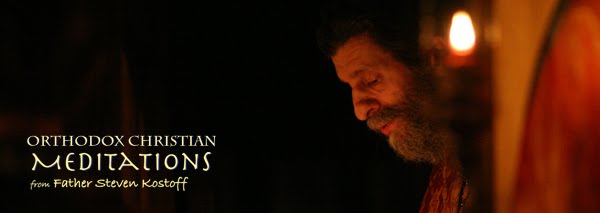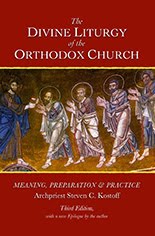
Dear Parish Faithful & Friends in Christ,
Today is the last day of Summer, and that means that Fall/Autumn begins tomorrow, September 22, at 5:18 p.m. EDT. At least for those of us in the Northern Hemisphere. Today is also the last day - the Leavetaking - of the Feast of the Elevation of the Cross. This Feast is celebrated with a full octave, or eight days of liturgical commemoration and celebration. This is simply one indication of the central place of the Cross in the life of the Church. It is virtually impossible to be a Christian without an ongoing consciousness of the Cross and a sense of awe before it:
The Feast of the Elevation of the Cross can also be called "A Tale of Two Trees." The tree of the knowledge of good and evil, planted in the midst of Paradise, became a source of condemnation; while the Tree of the Cross, planted on Golgotha, became a source of "eternal justice." In disobedience to God, the man and woman of GEN. 3, ate of the fruit of the tree that they were commanded to avoid, thus introducing the spiritual death of sin into the world. In contrast to this and in total obedience to the will of the Father, Christ ascended the Tree of the Cross in order to put sin to death, restore our broken will, and recreate our fallen human nature. In a lengthy hymn that is theologically rich and rhetorically impressive, we can meditate upon this "Tale of the Two Trees" that beautifully connects Paradise - "whatever that means," according to the enigmatic phrase St. Gregory the Theologian - and Golgotha:
This hymn is an excellent example of what Met. John Zizioulas has called our "liturgical dogmatics," understanding the "rule of prayer" as a source and/or expression of our "rule of faith." We pray what we proclaim to be our Faith, and not just frame that Faith in abstract or intellectual formulas. Even further, we actually bow down in worship before the Cross that we believe to be "Tree of true life" (Great Vespers of the Feast). In most icons of the Crucifixion, right beneath the foot of the Cross, buried on Golgotha, there is visible the skull of Adam, being "washed" by the blood of Christ that pours from His wounds. This is not presented as history but as a "visible theology" that again makes the profound connection between the first and last Adam. The "blood of God" cleanses and recreates our fallen human nature.
There is also a strong hint at cosmological restoration, or of nature mysteriously participating in the redemption gained through the Cross, as expressed in certain other hymns of the Feast:
We need to treat our forests with respect as each tree partakes of a mystical sanctification based upon its sharing of nature with the Tree/wood of the Cross!
Besides the typological, Christological and cosmological insights of the Feast, we never lose sight of the Cross in our lives, or of the Cross in relation to our own personal crosses. For this reason, the Gospel on the Sunday After the Feast of the Elevation is taken from MK. 8:34-9:1. This is the passage in which Jesus reminds anyone who desires to follow him to practice self-denial: "If any man would come after me, let him deny himself and take up his cross and follow me." (MK. 8:34) Every Christian is painfully aware of the difficulty of practicing self-denial. It is a veritable cross in and of itself. Conscious restraint and limitation seems like nothing more than painful constraint and self-imprisonment. Perhaps because we are inclined toward some form or another of "self-indulgence." In fact, we could be only one temptation away from "losing it" at any given time. We gain no assistance from the surrounding culture, since we are encouraged to pursue some aspect of self-indulgence with far greater passion than self-denial. Putting that another way, we could say that the only practice our culture denies is that of self-denial. In this light our entire life as Christians can be understood as a ceaseless struggle between the impulses of self-indulgence and the sobriety of self-denial. Food, drink, sex, money, status, etc. We can possibly "have it all," but Christ warns us that we can lose our soul/life in the process. But as clear as all of this is, we still continue to struggle. We have spent a great deal of time and energy -and money - building up our appetites. Would we even practice any self-denial without the fasting seasons appointed by the Church?! Let us thank God for those seasons, and the examples of the many great saints of the Church - men and women - who practiced blessed self-denial and gained their life through it.
As we approach the Fall season, we will again be treated to the flaming colors that give us a taste of the beauty of the created world. These natural "burning bushes" fill us with delight. And the trees that will provide that experience are images of the Tree of the Cross.
The Cross is raised on high, and urges all the creation to sing the praises of the undefiled Passion of Him who was lifted high upon it. For there it was that He killed our slayer, and brought the dead to life again: and in His exceeding goodness and compassion, He made us beautiful and counted us worthy to be citizens of heaven. Therefore with rejoicing let us exalt His Name and magnify His surpassing condescension. (Great Vespers of the Feast)
The Feast of the Elevation of the Cross can also be called "A Tale of Two Trees." The tree of the knowledge of good and evil, planted in the midst of Paradise, became a source of condemnation; while the Tree of the Cross, planted on Golgotha, became a source of "eternal justice." In disobedience to God, the man and woman of GEN. 3, ate of the fruit of the tree that they were commanded to avoid, thus introducing the spiritual death of sin into the world. In contrast to this and in total obedience to the will of the Father, Christ ascended the Tree of the Cross in order to put sin to death, restore our broken will, and recreate our fallen human nature. In a lengthy hymn that is theologically rich and rhetorically impressive, we can meditate upon this "Tale of the Two Trees" that beautifully connects Paradise - "whatever that means," according to the enigmatic phrase St. Gregory the Theologian - and Golgotha:
Come, all ye peoples, and let us venerate the blessed Wood, through which the eternal justice has been brought to pass. For he who by a tree deceived our forefather Adam, is by the Cross himself deceived; and he who be tyranny gained possession of the creature endowed by God with royal dignity, is overthrown in headlong fall. By the blood of God the poison of the serpent is washed away; and the curse of a just condemnation is loosed by the unjust punishment inflicted on the Just. For it was fitting that wood should be healed by wood, and that through the Passion of One who knew not passion should be remitted all the sufferings of him who was condemned because of wood. But glory to Thee, O Christ our King, for Thy dread dispensation towards us, whereby Thou has saved us all, for Thou art good and lovest mankind. (Great Vespers of the Feast)
This hymn is an excellent example of what Met. John Zizioulas has called our "liturgical dogmatics," understanding the "rule of prayer" as a source and/or expression of our "rule of faith." We pray what we proclaim to be our Faith, and not just frame that Faith in abstract or intellectual formulas. Even further, we actually bow down in worship before the Cross that we believe to be "Tree of true life" (Great Vespers of the Feast). In most icons of the Crucifixion, right beneath the foot of the Cross, buried on Golgotha, there is visible the skull of Adam, being "washed" by the blood of Christ that pours from His wounds. This is not presented as history but as a "visible theology" that again makes the profound connection between the first and last Adam. The "blood of God" cleanses and recreates our fallen human nature.
There is also a strong hint at cosmological restoration, or of nature mysteriously participating in the redemption gained through the Cross, as expressed in certain other hymns of the Feast:
Let all the trees of the wood rejoice, for their nature is made holy by Christ, who planted them in the beginning and who was outstretched upon the Tree. At its Exaltation on this day, we worship Him and thee do we magnify. (Matins, First Canon, Canticle Nine)
We need to treat our forests with respect as each tree partakes of a mystical sanctification based upon its sharing of nature with the Tree/wood of the Cross!
Besides the typological, Christological and cosmological insights of the Feast, we never lose sight of the Cross in our lives, or of the Cross in relation to our own personal crosses. For this reason, the Gospel on the Sunday After the Feast of the Elevation is taken from MK. 8:34-9:1. This is the passage in which Jesus reminds anyone who desires to follow him to practice self-denial: "If any man would come after me, let him deny himself and take up his cross and follow me." (MK. 8:34) Every Christian is painfully aware of the difficulty of practicing self-denial. It is a veritable cross in and of itself. Conscious restraint and limitation seems like nothing more than painful constraint and self-imprisonment. Perhaps because we are inclined toward some form or another of "self-indulgence." In fact, we could be only one temptation away from "losing it" at any given time. We gain no assistance from the surrounding culture, since we are encouraged to pursue some aspect of self-indulgence with far greater passion than self-denial. Putting that another way, we could say that the only practice our culture denies is that of self-denial. In this light our entire life as Christians can be understood as a ceaseless struggle between the impulses of self-indulgence and the sobriety of self-denial. Food, drink, sex, money, status, etc. We can possibly "have it all," but Christ warns us that we can lose our soul/life in the process. But as clear as all of this is, we still continue to struggle. We have spent a great deal of time and energy -and money - building up our appetites. Would we even practice any self-denial without the fasting seasons appointed by the Church?! Let us thank God for those seasons, and the examples of the many great saints of the Church - men and women - who practiced blessed self-denial and gained their life through it.
As we approach the Fall season, we will again be treated to the flaming colors that give us a taste of the beauty of the created world. These natural "burning bushes" fill us with delight. And the trees that will provide that experience are images of the Tree of the Cross.
At the exaltation of the Wood that is sprinkled with the blood of the incarnate Word of God, sing praises, ye powers of heaven, feasting the restoration of mortal men. Ye people, venerate the Cross of Christ, whereby resurrection has been granted to the world unto all ages. (Matins, First Canon, Canticle Eight)
Fr. Steven







